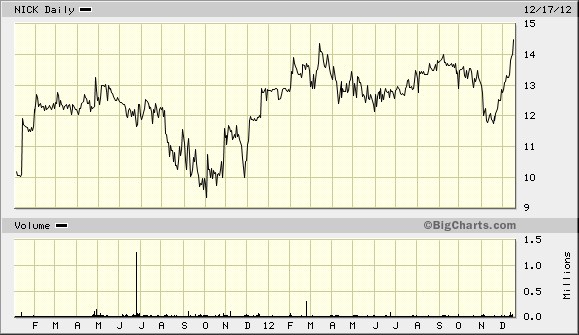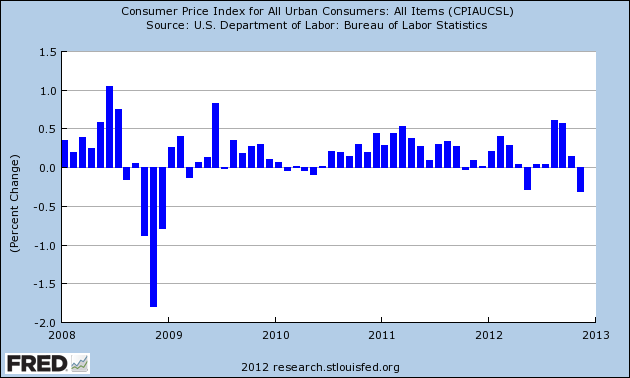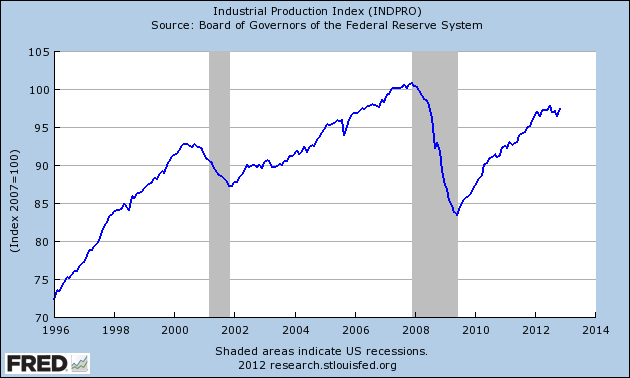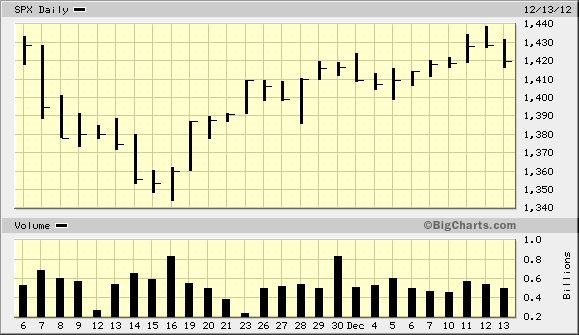Archive for December, 2012
-
Nicholas Financial Hits All-Time High
Eddy Elfenbein, December 17th, 2012 at 3:12 pmIt took us a while but Nicholas Financial ($NICK) finally got to an all-time high today. The shares got as high as $14.62 per share. Bear in mind that the stock will fall about $2 per share once the special dividend is paid out.
-
About Those Predictions….
Eddy Elfenbein, December 17th, 2012 at 11:01 amThe financial media is full of predictions for the year ahead. Most particularly, they seem interested in where people think the Dow will be at the end of next year.
Let me strongly urge readers to not take these guessing games too seriously. At the level of a parlor game, I suppose they can be fun. But the best part about our strategy of investing is that you don’t have to be able to predict anything. Nor do you have to be an expert on Fed policy or the euro crises.
What we specialize in is very, very, very low-risk predictions. For example, I predict that in one year’s time Bed Bath & Beyond ($BBBY) will continue to be a well-run company. True, it’s not a sexy prediction and it’s not guaranteed to make us money, but it’s still pretty important. Not all companies can say that.
Remember that the goal isn’t about being a perfect predictor, it’s about being a good investor. In a world where we can’t predict much, I place great emphasis on those things I can rely on. Keep that in mind when you go about investing.
-
Boehner Breaks the Stalemate
Eddy Elfenbein, December 17th, 2012 at 9:58 amThe stock market has started the week on the up side. The most prominent news is that House Speaker John Boehner seems willing to accept a compromise in which tax rates for the wealthy have to rise. People who watch these sorts of things believe Boehner’s move is a tipping point. My take is that the real negotiations have begun. Up till now, it’s mostly been posturing.
In Japan, the Liberal Democratic Party won a big election landslide and the stock market there responded positively. The S&P 500 had an unusual week last where it slowly rallied during the first half and slowly sank at the back half. The turning point came Wednesday afternoon after the Fed’s policy statement came out.
So far, the big banks are the top-performers today. Our own JPMorgan Chase ($JPM) is up over 1% (which is actually one of the poorer performers among the big banks).
-
Morning News: December 17, 2012
Eddy Elfenbein, December 17th, 2012 at 7:28 amFinest Hour for Draghi and Europe
Santander Agrees To Absorb Banesto
China Seeks to Lift Domestic Demand
UBS Said to Face $1.6 Billion Libor Penalty This Week
For Spaniards, Having a Job No Longer Guarantees a Paycheck
Zurich Insurance Sees $700 Million of Hurricane Sandy Claims
Forecast Is Sunnier, but Washington Casts a Big Shadow
AIG Offers to Sell as Much as $6.5 Billion of AIA Shares
Exxonmobil Sees Gas Displacing Coal As World’s No. 2 Energy Source
BP Sells Interest In North Sea Gas Field To SSE For $288 Million
Sprint Sweetens Bid For Clearwire To $2.2 Billion
First Quantum Increases Inmet Offer 2.9% to $5.18 Billion
Toyota Set to Seize Auto Sales Crown as GM Vies for No. 2
Diet Pepsi Quietly Changes Its Sweetener
Joshua Brown: Seven Ways to Make 2013 Your Most Productive Year Ever
Jeff Miller: Weighing the Week Ahead: Clarity Coming on Key Market Challenges?
Be sure to follow me on Twitter.
-
Inflation at Lowest Rate in Four Years
Eddy Elfenbein, December 14th, 2012 at 11:30 amThe gold market has been telling us the truth — real interest rates are too high. Despite the Fed keeping nominal short-term rates at 0%, prices have been falling recently which means that real interest rates have been positive. As my gold model suggests, that leads to a lower price for gold which is exactly what’s been happening.
Today’s report on consumer prices for November from the Labor Department said that prices fell 0.3% last month.
Economists polled by Reuters had expected consumer prices to fall 0.2 percent.
The so-called core C.P.I., which excludes food and energy prices, edged up 0.1 percent after rising 0.2 percent in October. Although food prices rose 0.2 percent in a lagged response to the summer drought, price pressures remain tame.
Going by the seasonally adjusted rate, this is the biggest drop in four years.
-
Industrial Production Rises 1.1% in November
Eddy Elfenbein, December 14th, 2012 at 10:01 amMore good economic news. Last month, industrial production rose by the most in two years.
Output at factories, mines and utilities increased 1.1 percent last month after a revised 0.7 percent drop in October that was more than initially estimated, the Federal Reserve reported today in Washington. Economists forecast a 0.3 percent advance, according to the Bloomberg survey median. Manufacturing, about 75 percent of production, surged 1.1 percent in November, the most this year.
Further gains in manufacturing, which has stumbled in the second half of the year, would help the expansion build on the recent pickup in housing and sustained consumer spending. At the same time, the industry faces the hurdles of slower global economies and a lack of clarity on the U.S. budget that has prompted companies to hold back on investment.
-
“We Have a Lot of Room to Profitably Grow”
Eddy Elfenbein, December 14th, 2012 at 9:45 amFord CEO Alan Mulally discusses his company and splits some infinitives.
Bloomberg TV is taking a look at Ford all day today so there are lots of good videos to see here.
-
CWS Market Review – December 14, 2012
Eddy Elfenbein, December 14th, 2012 at 7:42 amThe stock market is a giant distraction to the business of investing. – Jack Bogle
The S&P 500 rose for six straight days, and on Thursday, for the 13th time in a row, the index failed to extend a six-day winning streak into a seven-day streak. Nevertheless, the market continues to do well, which is exactly as I suspected. I’m still holding to my view that the market will rally well into 2013; this is a good time to be an investor.
This was an eventful week. On Wednesday, the Federal Reserve made news by announcing economic triggers for its interest rate policy. The stock market responded by surging to a two-month high. I’ll explain what it all means for investors in just a bit. Perhaps the best news of the week was that Nicholas Financial ($NICK) joined the special dividend parade by announcing a monster $2-per-share dividend. Percentagewise, that’s a big deal, and the stock surged.
Let me also remind you that next week, I’ll unveil our 2013 Buy List. I won’t start tracking the new list until the start of the year. I’m happy to report that the current Buy List is ending the year on a strong note. Since August 2nd, our Buy List has more than doubled the S&P 500, 9.2% to 4%. It looks like we’re going to narrowly beat the S&P 500 for our sixth-straight market-beating year. Now let’s take a look at the Fed’s announcement this week and what it means for us.
The Fed Lays Its Card on the Table
Meetings of central bankers are usually rather dull affairs, and that’s probably how it ought to be. This past week, however, the Federal Reserve actually did something interesting. For the first time, the Fed laid out specific trigger points for its interest rate policy.
Let me explain, and I’ll try to avoid any econo-speak. When the economy went into the toilet, the Fed responded by slashing interest rates. In fact, they even cut rates to 0%. After all, that’s what models say you should do. The problem was that the model even said to go into negative rates. The Fed responded by doing the equivalent—they started buying bonds—or as economists call it, “Quantitative Easing” (QE if you want to sound cool).
The Fed then ran into another problem. The central bank was simply announcing a bond-buying program with a price tag. Once that ran out, they announced another. Then another. Then in September, the Fed took a step back and said “Look, this isn’t working. Forget these dollar amounts and deadlines. We’re going to keep buying bonds and we’re not going to stop until things get better. That’s that.”
To be more specific, the Fed said it was going to buy $40 billion of agency mortgage-backed securities (MBS) each month. In practical terms, the Fed swaps assets with a bank. The Fed gets a risky MBS, while the bank gets low-risk reserves, which, I should add, are held at (guess where?) the Federal Reserve.
The game-changer in September wasn’t the $40 billion number. It’s that the Fed said it was going to go all in until things got better. By taking a time horizon off the table, the Fed sent a clear signal to investors that it was going to do what it had to in order to help the economy. But there was still the question “how will we know when things get better?” That’s where this week’s news comes in. But first let me quote the CWS Market Review from September 21:
An idea gaining popularity among economists is that the Fed should buy bonds until some metric like the unemployment rate or nominal GDP hits a specific target. With today’s news, the Fed has clearly moved towards that position without expressly saying so. The Fed said that the bond buying would continue until the labor market improved “substantially” and “for a considerable time after the economic recovery strengthens.”
In this week’s policy statement, the Fed gave us an answer. They said they won’t raise interest rates as long as the unemployment rate is over 6.5% (we’re currently at 7.7%) and inflation is under 2.5%. Basically, this means that rates are going to stay low for a long while more.
There are a few key takeaways: This is especially good news for financial stocks. Nicholas Financial ($NICK), for example, borrows money at the short end of the yield curve. The lower rates are, the better it is for them. In fact, I think a lot of the major banks are going for good values. Given the current conditions, I think JPMorgan Chase ($JPM) will have a very profitable 2013.
The housing market should also continue to get better. This has been an underreported story this year. A key difference between the current “Quantitative Easing” and the previous attempts is that back then, the housing market was still in free fall. Now it’s gaining strength, and in turn, that’s helping consumers. We don’t have the numbers in yet, but this may turn out to be a good holiday shopping season. We just got the retail sales report for November, and it was pretty good. The initial jobless claims report came very close to hitting a five-year low (which means the spike from Hurricane Sandy has now passed).
This new Fed policy will also be good for economically sensitive “cyclical” stocks. These are sectors like energy, transportation and heavy industry. There’s also a key “double whammy” effect with cyclicals since they tend to outperform the market when the market itself is doing well. I like to follow how the Morgan Stanley Cyclical Index ($CYC) performs relative to the S&P 500, and it’s improved very nicely since the summer. The CYC-to-S&P 500 ratio is close at an eight-month high. I should warn you that Q4 GDP will probably be a dud (0% to 1% growth), but we may see greater than 3% growth toward the latter half of 2013.
This week’s Fed news is a clear signal that the Fed is in the investors’ corner and is willing to boost the economy for several more quarters. The risk right now is finding yourself getting left behind. Now let’s look at my second-favorite NICK of the holiday season.
Nicholas Financial’s Special Dividend
On Tuesday, Nicholas Financial ($NICK) announced a special $2-per-hare dividend. In previous issues, I’ve talked about how companies have announced special dividends before the end of the year so they won’t get hit by higher taxes, which are almost certainly on their way next year.
The major difference with NICK is that this is a pretty large dividend. It works out to be about 15% of the stock’s value. The dividend will be paid out on December 28th to shareholders of record as of December 21st. Also note that NICK is a Canadian company, so there may be foreign tax withholdings (please consult your tax advisor).
I want to clear up a few things about this dividend. This news, by itself, doesn’t do anything to boost NICK’s value. It’s simple math: Once the dividend is paid out, we can expect the shares to fall by $2. Since the dividend works out to be roughly one year’s worth of profits, we shouldn’t expect any dividends next year.
While the special dividend doesn’t add value to NICK, the perception did, as the value of the stock rallied nicely on Wednesday, getting as high as $14.14 per share. Why did it rally? That’s hard to say exactly, but it was probably an appreciation of the company’s boldness. Think of it this way: You’re not going to pull a big move like that unless you’re pretty darn confident about your business’s ability to rake in cash. Traders took notice. NICK continues to be a very good buy.
Earnings from Oracle and Bed, Bath & Beyond
Next week, we’ll get earnings reports from Oracle ($ORCL) and Bed, Bath & Beyond ($BBBY). Also, BBBY will lay out some important planning assumptions for next year. Both of these companies wrapped up the end of their quarter in November.
Oracle made news last week by announcing that they’re going to pay out their next three dividends before the end of the year in order to avoid the taxman. The company will report its fiscal Q2 earnings on Tuesday, December 18th. In September, Oracle told us to expect earnings to range between 59 and 63 cents per share. The Street expects 61 cents per share, which Oracle should be able to beat.
Last quarter, Oracle got dinged by currency costs. That’s frustrating, but I’m not particularly worried, since those tend to be transient concerns. I’d be much more concerned by a downturn in their overall business, and Oracle isn’t experiencing that. I’ll be interested to hear what Ellison & Co. have to say about fiscal Q3 and how badly Europe is hurting then. I continue to like Oracle a lot and rate it a good buy up to $35 per share.
Bed Bath & Beyond is due to report on Wednesday, December 19th. In June, BBBY surprised Wall Street (and me) by guiding lower for their August quarter. The stock got hammered, and analysts quickly slashed their forecasts. When the results came out in September, BBBY still came in four cents below consensus. It was just an ugly quarter, which is very uncharacteristic of BBBY.
The problem is that Bed Bath & Beyond had become overly reliant on coupons to get feet in the door. I understand the temptation, but a retailer can’t discount their way to sales for the long-term. I’m not giving up on BBBY. This is a very well-run outfit, and they’ve already steered their way though an historic housing bust. I think they can handle this.
Interestingly, the guidance for Q3 was 99 cents to $1.04 per share, which really isn’t that bad. What traders seemed to overlook is that the company stood by its previous full guidance of earnings growth between the high single digits and low double digits. BBBY also has a rock-solid balance sheet. I currently rate BBBY a buy up to $62 per share. This is a solid company, and the shares are going for a good value.
Before I go, I want to make two adjustments to our Buy Below prices. Fiserv ($FISV) has been a monster for us this year. I’m raising our Buy Below price to $83 per share. Moog ($MOG-A) has been a lousy stock this year, but I think it’s an exceptionally good value. I’m raising the Buy Below on Moog to $40 per share.
That’s all for now. Next week, we’ll get earnings from Oracle and Bed, Bath and Beyond. The government will also update the Q3 GDP report. Be sure to keep checking the blog for daily updates. I’ll have more market analysis for you in the next issue of CWS Market Review!
– Eddy
-
Morning News: December 14, 2012
Eddy Elfenbein, December 14th, 2012 at 6:40 amBanks Spurn Europe Bond Rush Amid Central Bank Loan Largesse
Global Banking: Regulations Force a Retreat
Berlusconi Drags Merkel Into Italy Race in Monti Meeting
Fitch Keeps Pressure on France
Britain Bucks Trend As EU Car Sales Continue To Fall
JGB Investors Say Yen Weakening Isn’t Turning Point For Bond Market
China On Mend, But Euro Zone Still Shrinking
A Fed Focused on the Value of Clarity
U.S. Rejects Telecommunications Treaty
Sprint’s Clearwire Acquisition In Trouble As Softbank Caps Bid
Hostess Said to Attract Bids From Wal-Mart, Kroger
Mercedes Valued at Half of BMW as Zetsche Loses Investors
Building a Showcase Campus, Using an I.O.U.
Stone Street: Short the DeMarco Trade
Phil Pearlman: ReutersTV: The Apple VIX & How to Play It with Condor Options
Be sure to follow me on Twitter.
-
“We Don’t Produce Goods Here Anymore”
Eddy Elfenbein, December 13th, 2012 at 11:28 pmI noticed this quote in the New York Times:
“In sector after sector, we’ve lost our innovation edge because we don’t produce goods here anymore,” said Mitzi Montoya, dean of the college of technology and innovation at Arizona State University
I hear this a lot, that we don’t make things here anymore. But it’s flatly not true. It’s said as if it’s not an empirical fact that can be looked up.
The truth is that America is a manufacturing powerhouse. The difference is that far fewer Americans work in manufacturing — and that’s due precisely to our innovation.
-
-
Archives
- May 2025
- April 2025
- March 2025
- February 2025
- January 2025
- December 2024
- November 2024
- October 2024
- September 2024
- August 2024
- July 2024
- June 2024
- May 2024
- April 2024
- March 2024
- February 2024
- January 2024
- December 2023
- November 2023
- October 2023
- September 2023
- August 2023
- July 2023
- June 2023
- May 2023
- April 2023
- March 2023
- February 2023
- January 2023
- December 2022
- November 2022
- October 2022
- September 2022
- August 2022
- July 2022
- June 2022
- May 2022
- April 2022
- March 2022
- February 2022
- January 2022
- December 2021
- November 2021
- October 2021
- September 2021
- August 2021
- July 2021
- June 2021
- May 2021
- April 2021
- March 2021
- February 2021
- January 2021
- December 2020
- November 2020
- October 2020
- September 2020
- August 2020
- July 2020
- June 2020
- May 2020
- April 2020
- March 2020
- February 2020
- January 2020
- December 2019
- November 2019
- October 2019
- September 2019
- August 2019
- July 2019
- June 2019
- May 2019
- April 2019
- March 2019
- February 2019
- January 2019
- December 2018
- November 2018
- October 2018
- September 2018
- August 2018
- July 2018
- June 2018
- May 2018
- April 2018
- March 2018
- February 2018
- January 2018
- December 2017
- November 2017
- October 2017
- September 2017
- August 2017
- July 2017
- June 2017
- May 2017
- April 2017
- March 2017
- February 2017
- January 2017
- December 2016
- November 2016
- October 2016
- September 2016
- August 2016
- July 2016
- June 2016
- May 2016
- April 2016
- March 2016
- February 2016
- January 2016
- December 2015
- November 2015
- October 2015
- September 2015
- August 2015
- July 2015
- June 2015
- May 2015
- April 2015
- March 2015
- February 2015
- January 2015
- December 2014
- November 2014
- October 2014
- September 2014
- August 2014
- July 2014
- June 2014
- May 2014
- April 2014
- March 2014
- February 2014
- January 2014
- December 2013
- November 2013
- October 2013
- September 2013
- August 2013
- July 2013
- June 2013
- May 2013
- April 2013
- March 2013
- February 2013
- January 2013
- December 2012
- November 2012
- October 2012
- September 2012
- August 2012
- July 2012
- June 2012
- May 2012
- April 2012
- March 2012
- February 2012
- January 2012
- December 2011
- November 2011
- October 2011
- September 2011
- August 2011
- July 2011
- June 2011
- May 2011
- April 2011
- March 2011
- February 2011
- January 2011
- December 2010
- November 2010
- October 2010
- September 2010
- August 2010
- July 2010
- June 2010
- May 2010
- April 2010
- March 2010
- February 2010
- January 2010
- December 2009
- November 2009
- October 2009
- September 2009
- August 2009
- July 2009
- June 2009
- May 2009
- April 2009
- March 2009
- February 2009
- January 2009
- December 2008
- November 2008
- October 2008
- September 2008
- August 2008
- July 2008
- June 2008
- May 2008
- April 2008
- March 2008
- February 2008
- January 2008
- December 2007
- November 2007
- October 2007
- September 2007
- August 2007
- July 2007
- June 2007
- May 2007
- April 2007
- March 2007
- February 2007
- January 2007
- December 2006
- November 2006
- October 2006
- September 2006
- August 2006
- July 2006
- June 2006
- May 2006
- April 2006
- March 2006
- February 2006
- January 2006
- December 2005
- November 2005
- October 2005
- September 2005
- August 2005
- July 2005




 Eddy Elfenbein is a Washington, DC-based speaker, portfolio manager and editor of the blog Crossing Wall Street. His
Eddy Elfenbein is a Washington, DC-based speaker, portfolio manager and editor of the blog Crossing Wall Street. His